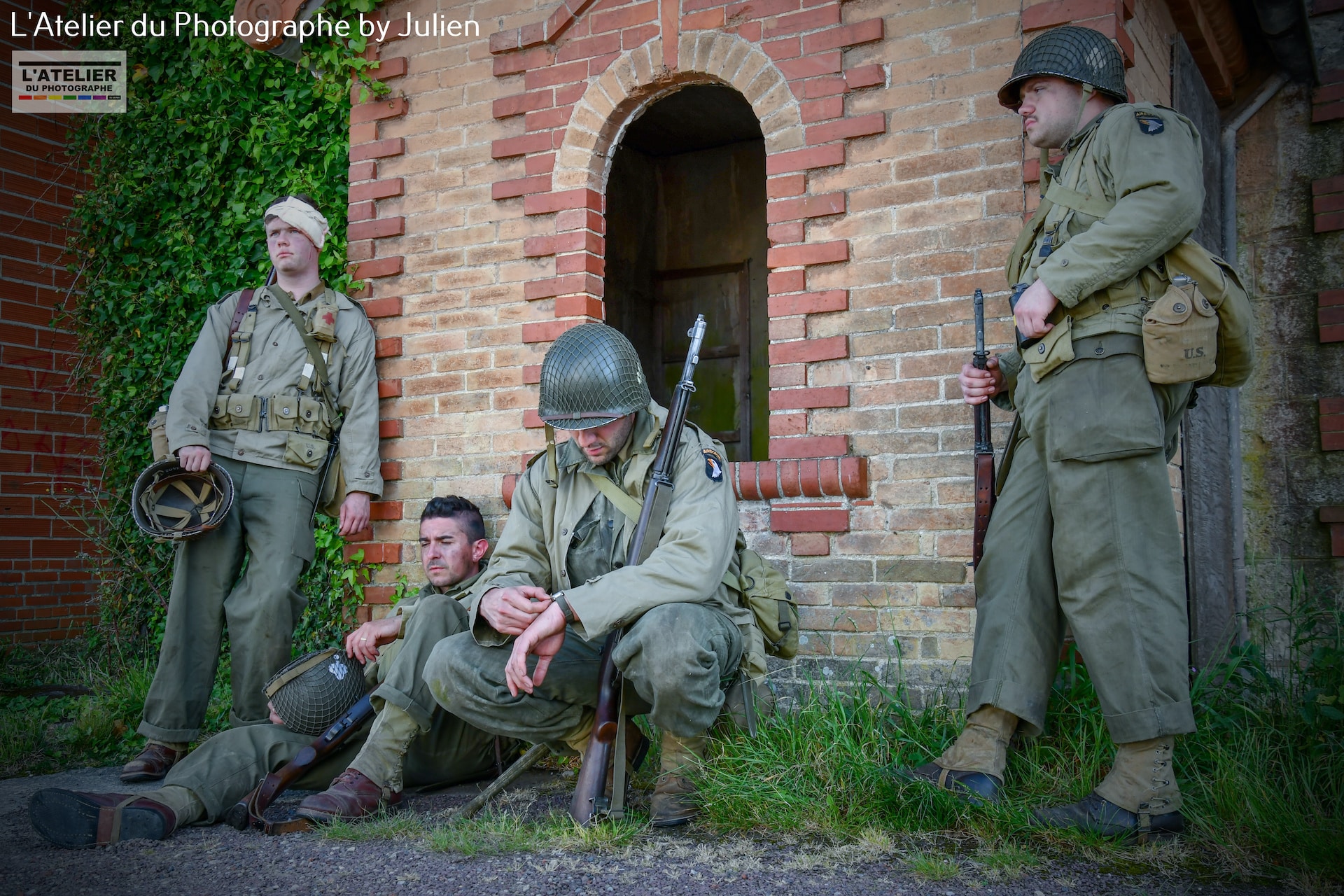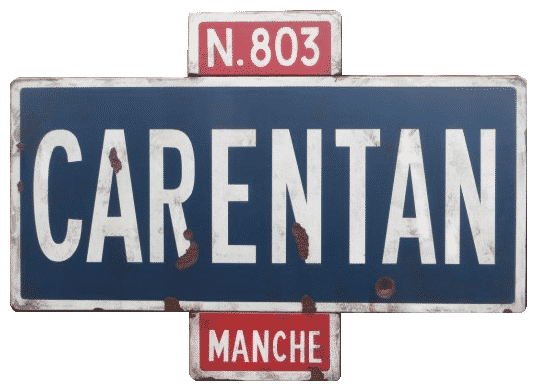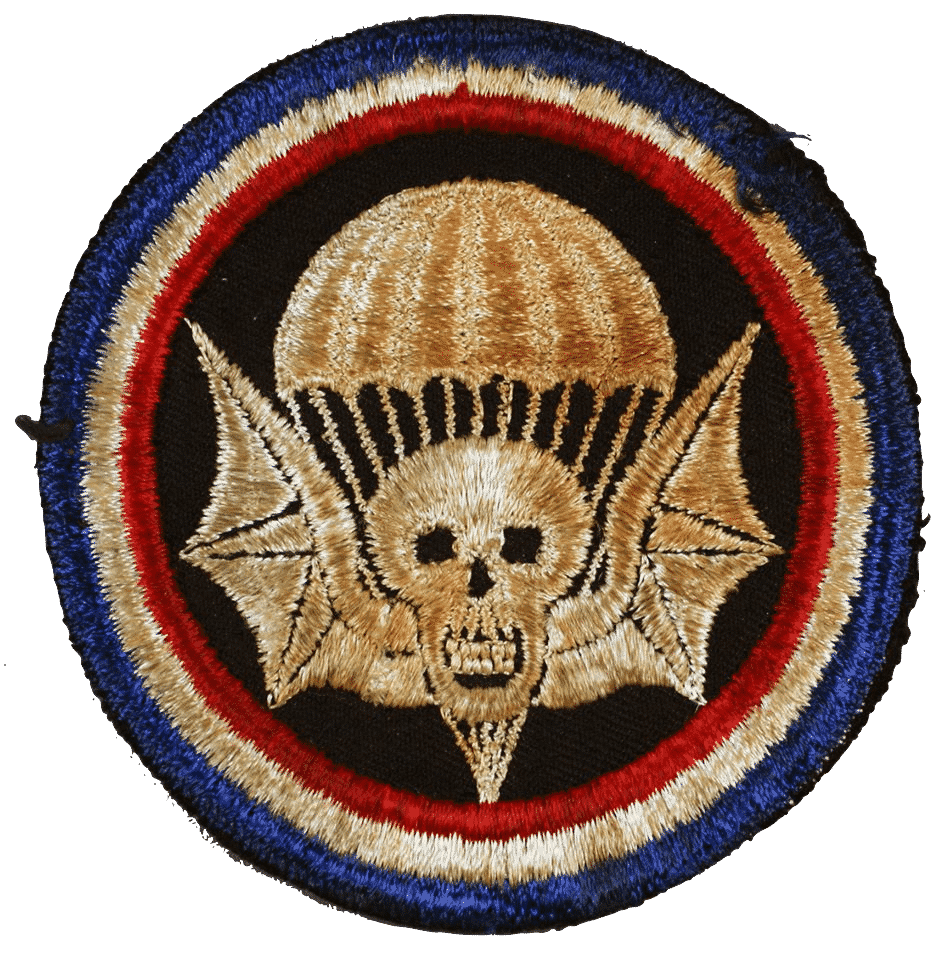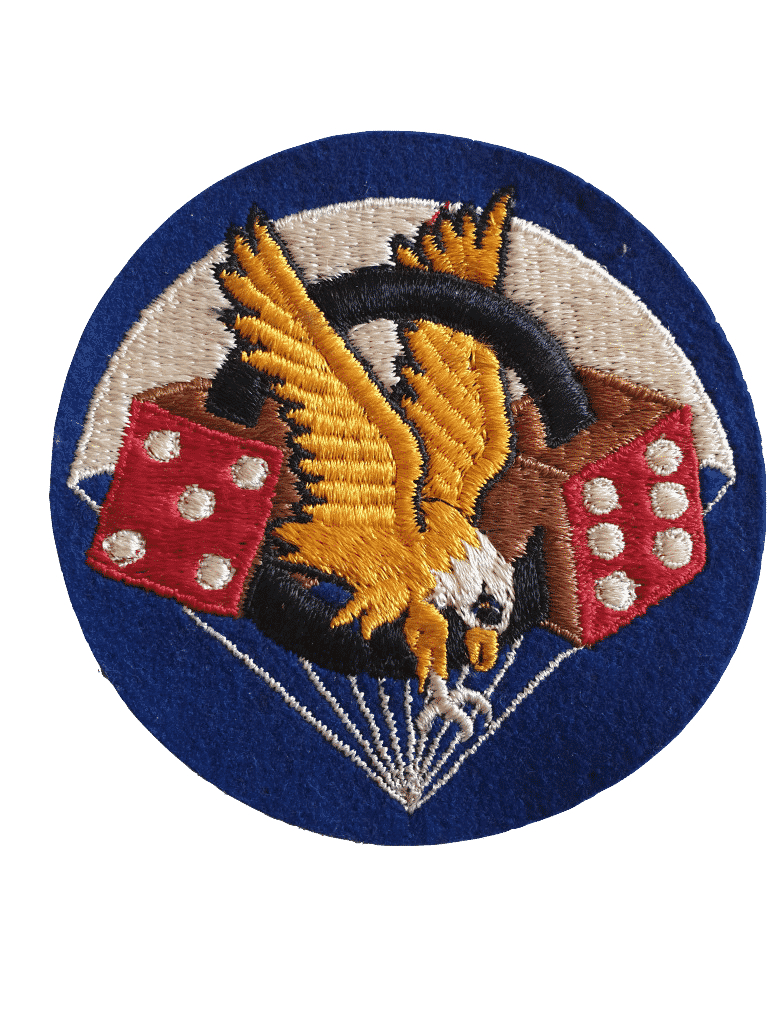The 327th GIR comes ashore on Utah Beach; "Uncle Red" sector
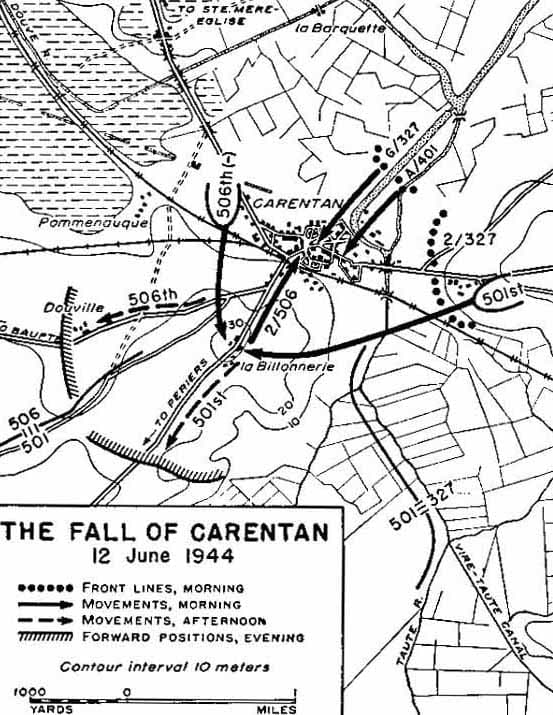
It soon became clear that the lack of gliders would force the 327th GIR, and their third battalion from the 401st to reach Normandy by sea. On the third week of May 1944, the men were confined to their assembly area in Wales, where they worked on making their gear, weapons and radios watertight. Only the regiment’s anti tank platoon would take part in the airborne assault. Six gliders would take them from Aldermaston.
The men from the 327th and the 401st left England on the afternoon of the 5th June aboard landing crafts. They were supposed to come ashore after the 4th ID on Utah Beach on 6th June. The 401st were the first ashore. Headquarters company from the 327th with the commanding officer, George Wear followed, but most of the 327th were unable to come ashore. It was only on 7th June that the 327th and the remainder of the 401st finally made it ashore and walked to Sainte Marie du Mont. The 401st was briefly attached to Bob Sink’s 506th PIR to support their attack on St Côme du Mont. Their chaplain, Father Steel was accidentally killed by a guard from the 506th…
Colonel Allen led his companies of the 401st on the attack on the dawn of 8th June across the lines of the 2/501st towards Hell’s Corner and to the first bridges on the RN 13 road, which would soon be called Purple Heart’s Lane. The Germans blew up the bridge over the Douve, and the 401st was held up by German machine gun fire. They spent the night in Saint Côme and on the morning of 9th June were attached to 327th GIR.
At around 2000hrs on 8th June, units from the 327th headed towards the bombed bridges to the south of the la Barquette locks near Brévands, to take over from the 506th PIR. They held the sector located between the lock and the Douve estuary.
On the morning of 9th June, the 327th was spread out along the left bank (north) of the Douve, opposite Brévands. They spent the whole day preparing. The Engineers prepared inflatable craft. Lieutenant Carlton Werner swam across the Douve. He found a boat on the other side and decided to bring it back putting a rope around his waist. This boat allowed them to send another patrol across later that day led by Lt Kenneth Vyn, 2nd Platoon, A company. The patrol encountered an ambush. Vyn and four men were injured. Corporal Harry O. Mayner was killed. The patrol attempted to cross the Douve again, but their boat was destroyed by mortar fire. Although they were injured the men swam back. At nightfall, the inflatable boats were carried to the edge of the river. C Company was to lead the first attack with Captain Robert Galbraith commanding. On the other side of the Douve, 3 German bunkers threatened. At 0145 hrs on 10th June, C Company, 1/327th crossed the Douve on the inflatable craft. C Company came under artillery fire and suffered badly. Some people say it was friendly fire.
There were not enough boats and 2/327th crossed on foot. By 0600hrs on 10th June, 1 and 2 battalions from the 327th GIR had made it to the southern bank of the Douve. At around 0700hrs, the glider men took over the village of Brévands. The Germans fled after destroying the church. It was also at around 7 in the morning that taking advantage of low tide, the 401st from Le Groseiller crossed the Douve on foot. The men from the 327th and 401st began a battle that would last two days on the southern bank of the river in order to liberate Carentan.
Bud Harper heads up the 327th GIR
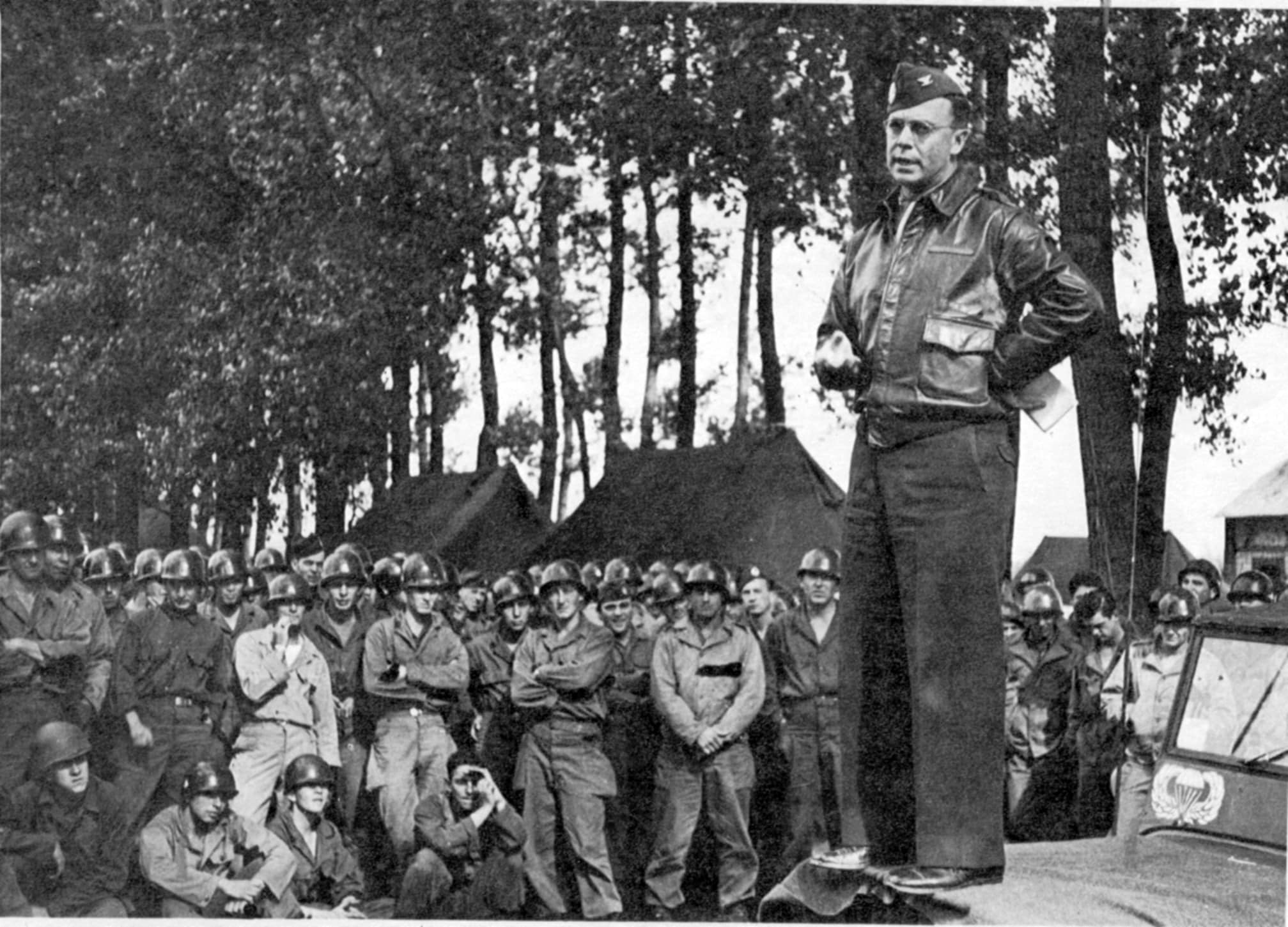 |
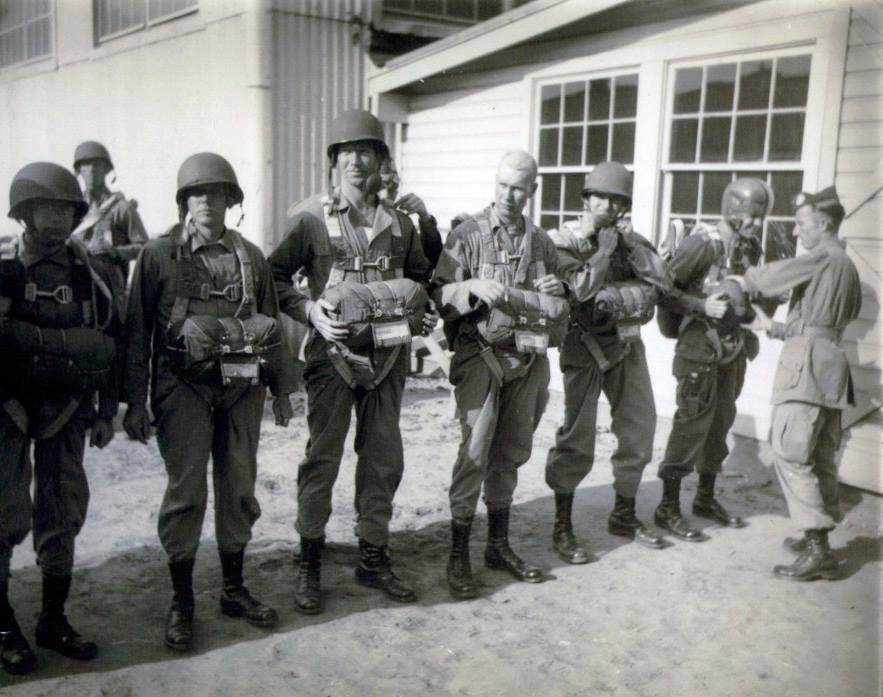 |
On Saturday 10 June, Colonel Bud Harper is still at Utah Beach where he is acting as Beachmaster for the units of the 101st making their approach from the sea. He is urgently summoned to the division’s HQ in Hiesville. Once there he discusses the line of attack on Carentan with Max Taylor. The latter shows him the location of the 327th and orders him to take over the supervision of operations as a replacement for Colonel George Wear. It appears that it is this officer that is to take the rap for the losses suffered on 9 June by C/327th, which was decimated by friendly fire as it was trying to cross the Douve River. Wear didn’t respect the timing and by making the crossing too early, the Glidermen from C as well as B/327th came under friendly fire… One thing for sure, is that the movements of the 327th from St Côme du Mont were very badly orchestrated, with battalions and companies blurring into inextricable chaos, which proved to be very annoying for McAuliffe in particular. Harper takes on Rouzie as second in command, whilst Renfro becomes G-3 of the 101st. Harper was highly valued by his men, who nicknamed him “Dig’em deeper”, a sign of the commitment that Harper had for the safety of his men at the front. From 02:00 hours on 10 June, Harper reorganised his battalions near Carentan from St Hilaire Petitville. At that point, the 327th and its third battalion from the 401st were the only American units present to the south of the Douve River.
Harper finds Wear in Brévands and hands over a letter to him that has been penned by Taylor. The two men salute each other and Harper heads off to locate the front line of the 327th near Carentan. The regiment’s line of attack is the Brévands road, with the right flank along the canal and the left flank very spread out as far as Vire. The firing from 88 has totally disrupted the two battalions, whose lines overlap each other without the slightest cohesion. Harper decides that the Brévands road marks the boundary between the two battalions, 1/327th to the right (looking towards Carentan), and 2/327th to the left, high up, to deliver fire support. The attack resumes at 22:00 hours, in a hail of tracer bullets from the heavy weapons division of the 2/327th. The first elements of the 1/327th reach the Bailey bridge and cross the small footbridge leading to the north bank of the canal. The bridge is half demolished and gets fixed overnight by the Glidermen. Harper is keen to get his troops into position via both sides of the wet dock. It’s the newly arrived A Company of the 401st, which is tasked with attacking via the east bank of the canal (on the left as you look towards Carentan) whilst G/327th goes on the attack on the other side of the canal.

Joining of the bridgeheads
The 327th Glider Infantry Regiment’s first mission was to cross the Douve River and make the Brévands hills secure. At 01:45 hours on the morning of Saturday 10 June, C company crosses the Douve in silence and sets up an initial bridgehead. The barrage of artillery and mortar that ensues in order to prepare for the rest of the regiment to make the crossing has such a powerful impact that the three battalions of the 327th are all safely across before 06:00 hours that morning. Brévands is occupied in the same breath. At midday, A company of the 1/401st Glider Infantry receives the order to lead a reconnaissance mission from the south of Brévands to Auville sur le Vey, on the west bank of the Vire River. Two kilometres further along, the company is exposed to strong opposition from the Germans.
It is Max Taylor himself who, on receiving a report about the significant number of German forces on the bridge from Vire to Auville sur le Vey, orders Colonel George Wear (still CO of the 327th GIR, albeit for just a few more hours), to dispatch a company to test enemy forces. Colonel Ray C Allen, head of the 1/401st is tasked with fulfilling this objective. He orders his A Company, under the command of Captain Eldridge Naugher, together with his 81mm mortar section, to make for Auville. During this time, Captain John Theodore King III, CO of K Company, 175th Infantry Regiment, 29th Infantry Division, receives the order from his division to advance westwards towards Vire so as to seize control of Auville sur le Vey and secure the bridge, even though it not known at that point whether or not it is still standing. King gets moving with his 150 men who had landed in Omaha on 7 June and made Isigny by forced march. They lead the charge on Auville, shooting on the run and shaking up the German defence, who flee across the fields. “A real Charge of the Light Brigade” Captain King says later. The bridge is down and the Twenty Niners have to make the crossing by foot. On arrival on the west bank of the Vire River, King is hit on both legs by a burst of fire from an MG 42.
Meantime, at the head of the Gliderist section of A Company/401st, two men, including Staff Sergeant John R Gacek (KIA Opheusden) belt along carrying a .30 calibre machine gun. Their charge causes the Germans, who were barring their way up to that point, to flee and at 14:00 hours, the two men entered Auverville and ran into a group of 29ers who were holding prisoners. The joining of the two bridgeheads is complete. Allen informs Taylor about it and heads of in a jeep to get in contact with the military staff of the Vth Corps in Isigny. Allen later returns with 6 Stuart tanks in a bid to finish cleaning up the sector with the 401st…
Slow progress towards the wet dock
With the two bridgeheads connected up, the capture of Carentan is deemed to be even more of a necessity in order to benefit from its solid road network and railway and to reinforce the American defences with a view to a German counter-attack. The 327th, with its 401st battalion has to launch a decisive attack from the north-east, enter the town and prevent the Germans from retreating into the Vire-Taute canal sector. Up until around 18:00 hours on 10 June, the three Glidermen battalions make rapid progress, albeit in disorderly fashion; Rouzie and his second battalion want to take the bridge as it joins the Douve. There they find Hartford Salee and his first battalion leading the attack against this same position despite a leg injury caused by machine gun fire. Salee has just lost three of his company’s commanders, killed by a single tree burst, where the exploding of a shell had come in contact with the top of the tree under which they were sheltered. It is Harper who comes in at a given point to reorganise these battalions. He prompts a reconnaissance mission towards the positions of the 401st in Le Rocher. He needs to get back to the Douve River to stand a chance of entering Carentan along the wet dock. The 1/327th goes on to occupy the left flank of the attack, and the 2/327th the right flank. The target is the far end of the wet dock, where the Vire Taute canal joins the Douve River. The attack begins at 22:00 hours on Saturday 10 June. Taking advantage of the last glimmers of daylight and with spectacular fire support from the regiment’s heavy arms, the two battalions reach the wet dock. A patrol from the 2/327th manages to cross the canal using a small, partially destroyed footbridge. On Harper’s orders, the patrol reinforces the bridge with planks and the men from Rouzie’s battalion gain a foothold at the edge of the wet dock, along the southern edge. At that time, Harper is envisaging two-pronged attack on both sides of the dock to force entry into Carentan. A company of Allen’s 401st is tasked with occupying the eastern section of the dock, whilst G company of the 327th is set to attack along the western section.
The attack and capture of Carentan
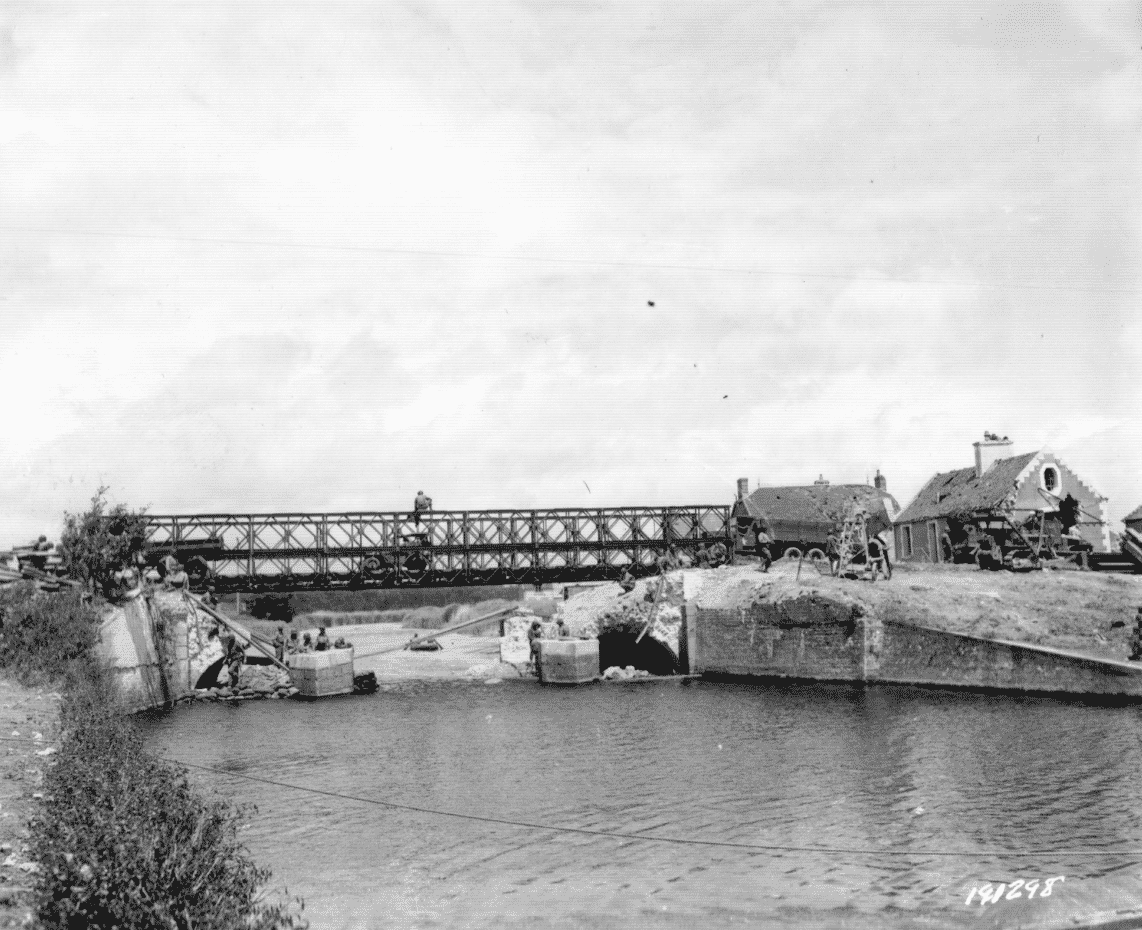
Entry into Carentan via the east is blocked by the Vire-Taute canal. The 327th Glider Infantry receives the order to capture all Carentan’s access points from the east, notably by securing the railway bridges as well as the road bridge to Isigny above the canal. The regiment makes quick progress on the afternoon of 10 June, but at 18:00 hours it is stopped in its tracks around 400 metres from the canal by enemy fire from the houses and fields on the west bank of the canal. The regiment groups back together to win back these 400 metres. The 2/327th advances along the northern side of the road, to the right of the canal, whilst the 1st battalion follows suit via the south. The 1/401st is to remain in reserve. This attack makes the enemy retreat to the other side of the canal and at around midnight, the two battalions of gliderists reached the final hurdle before the town, where they hid out for the night. The 327th was now within gunshot of the town and in control of the road bridge, which was the only bridge still intact.
The attack was launched at 10:00 hours on Sunday 11 June 1944 before the gaze of Max Taylor who had come along to watch proceedings. Amidst a barrage of artillery and German mortar fire, the two companies advance around 450 metres on both sides of the wet dock, amongst the trees, before being pinned to the ground by machine guns shooting from the town’s first houses. The companies have no room for manoeuvre and the men are hit by sniper fire and machine gun fire from the western section of the wet dock. Harper narrowly escapes death heading for the front line. The situation is at a standstill. Without effective artillery support, the attack falters and no more progress will be made that evening.
Task Force McAuliffe and a new line of attack on Carentan
Harper is summoned to the regiment’s headquarters at around 20:00 hours where he finds the Deputy Commander of the 1st Army, General Courtney Hodges, as well as Generals Taylor and McAuliffe, and Colonel Johnson of the 501st PIR. It is decided that a Task Force must be put together to unite and coordinate the final attack on Carentan. It is Anthony McAuliffe, commander of the 101st artillery, who is entrusted with the command of this Task Force.
Bob Sink’s 506th PIR replaces the 502nd, decimated in the attack on the Colline 30 to the south of Carentan. Harper has to hold out along the wet dock with his 401st renewing its attack along the west bank of the wet dock. Skeet Johnson’s Geronimos are requested to come out of their position in reserve and cross the Douve River on the afternoon of Sunday 11 June in Brévands to perform a wide, encircling movement via the east in order to link up with the 506th to the south of the town. They take advantage of the pneumatic bridge built by the Engineers of the 1,106th Engineer Combat Group. The Geronimos bivouac near Segueville and later in the evening Taylor makes it back to 506th headquarters in Angoville and personally gives Bob Sink the order to replace Michaelis’ 502nd PIR, by attacking from the Ingouf farm towards Pommenauque, with Colline 30 to the south of Carentan as the target.
The night of 11 June is a terrible one for Carentan. Enemy fire is fleshed out by the sound of American artillery, tanks and shells from the Navy’s big guns. Allen and his boys from the 401st hidden away along the wet dock, soon learn the true meaning of “dig deeper”, Bud Harper’s watchword!
At 05:00 hours on the morning of 12 June, the 401st leaps out of its foxholes along the length of the wet dock and charge on Carentan. The Glidermen are the first to enter the town, coming under fire from snipers hidden away in the houses. To the south, Bob Sink drives his 2/506th into the town, which he discovers is only occupied by a few snipers. Short of munition, Major Baron von der Heydte’s Fallschirmjaegers (paratroopers) have escaped under cover of darkness. At 07:30 hours on 12 June, paratroopers and glidermen link up in the town. Harper, Allen, and Colonel Bob Strayer, head of the 2/506th get together in a house not far from the station where they open a bottle of newly ‘liberated’ wine.
The 327th/401st in Normandy
The 327th/401st GIR suffer 524 losses in Normandy. It is important to bear in mind that the bulk of the regiment has arrived via the sea and so it has not had to lament ‘accidental’ losses, such as glider crashes in particular. As such, it is indeed the enemy fire which has brought about these losses. If we consider the fact that from 16 June, this regiment held a static position to the south-east of Carentan through until its withdrawal on 17 July, it is indeed during the attack on Carentan that the majority of these losses were suffered, namely 103 KIA, 406 WIA and 15 MIA.
